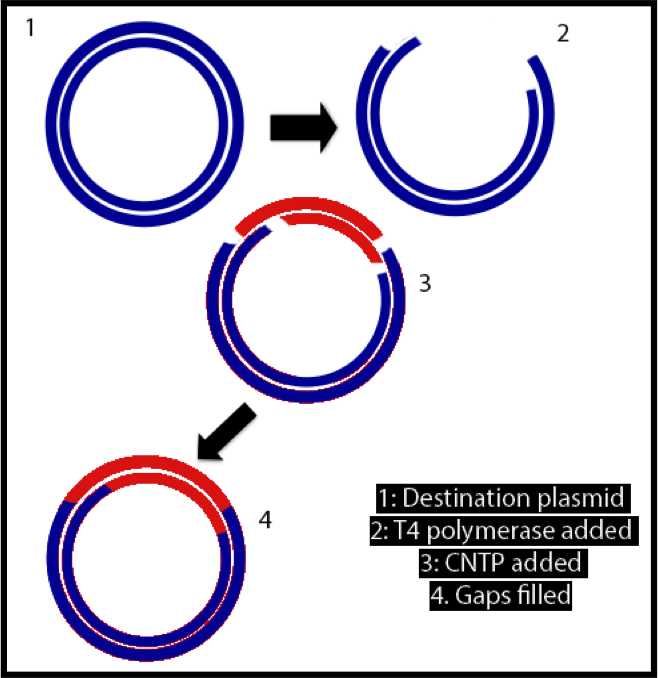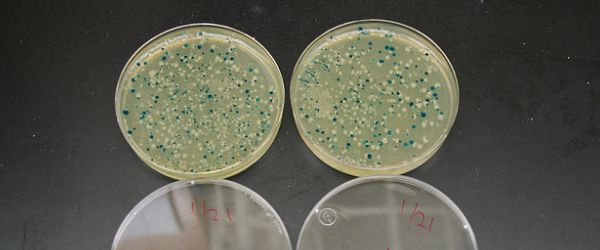Parents of small children attending nursery know that the period of time from September to June is a succession of colds and flues for the whole family – children with their underdeveloped immune system exchange viruses, creating new potent strains. Well, that’s probably how bacteria feel all the time in the natural environment teeming with bacterial viruses, or bacteriophages, which are probably the most abundant biological entities on the planet. The analogy between humans and microorganisms can be stretched even further: bacteria have something like an immune system, called a restriction-modification (RM) system, which recognizes an intruder and starts its destruction. Molecular biologists are usually familiar with one half of this system – restriction enzymes.
A restriction enzyme, for example R.EcoRI, is half of the RM system. The second half, a modification enzyme like M.EcoRI, recognizes the same DNA sequence (GAATCC) as the restriction enzyme. If this DNA sequence is bacterial DNA newly synthesized during replication, it will have a methyl group on one of the nucleotides of the “old” strand, and M.EcoRI will methylate the second strand (GAAmTCC), making it unreachable by the restriction enzyme. However, foreign DNA entering the bacterial cell (most frequently, phage DNA or a self-transmissible plasmid) will be completely unmethylated, which is detected by the restriction enzyme. The restriction enzyme then makes a double-strand break in the invading DNA, making it accessible to cellular nucleases and therefore prone to degradation. This is a simple but effective defense measure, like archers shooting enemies recognizable by their different uniforms, even though the enemy is already inside the city.
However, the phage-bacteria coevolutional warfare did not stop at a simple target-response interaction. Just like during medieval warfare, when there were siege towers to go over the walls and tunnels to go under them, the selective pressure resulted in bacteriophages acquiring mechanisms to block restriction enzymes. These strategies include incorporating exotic, non-ATGC bases, which impede restriction enzyme binding and sequence recognition; producing proteins that mimic DNA and block REs; and avoiding palindromic sequences, which are recognized by most restriction systems.
To counter these counter-defenses, bacterial strains usually have more than one RM system. For example, you’ve probably heard of HindIII; but did you know, the ‘III’ means that this is the third restriction enzyme identified in Haemophilus influenzae? Each of them recognises a different sequence.Moreover, bacterial genomes usually have not only several RM systems, but several types of RM systems, of which the enzymes routinely used in molecular biology (type II restriction enzymes) constitute only a fraction of the total defense arsenal. Some restriction enzymes lack their kindly twin (the modification enzyme) and cut only methylated DNA. Some recognize asymmetric (type III RM systems) or degenerate sequences, widening the target recognition range. Some (type I REs) cut at a random distance from their recognition site…it goes on and on!
Enjoying this article? Get hard-won lab wisdom like this delivered to your inbox 3x a week.

Join over 65,000 fellow researchers saving time, reducing stress, and seeing their experiments succeed. Unsubscribe anytime.
Next issue goes out tomorrow; don’t miss it.
The restriction enzymes wars have been going on for billions of years… long enough to make the Hundred Years’ War in Europe seem like something gone in blink of an eye.
You made it to the end—nice work! If you’re the kind of scientist who likes figuring things out without wasting half a day on trial and error, you’ll love our newsletter. Get 3 quick reads a week, packed with hard-won lab wisdom. Join FREE here.








